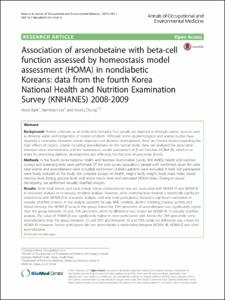KUMEL Repository
1. Journal Papers (연구논문)
1. School of Medicine (의과대학)
Dept. of Preventive Medicine (예방의학)
Association of arsenobetaine with beta-cell function assessed by homeostasis model assessment (HOMA) in nondiabetic Koreans: data from the fourth Korea National Health and Nutrition Examination Survey (KNHANES) 2008-2009.
- Keimyung Author(s)
- Chung, In Sung
- Department
- Dept. of Preventive Medicine (예방의학
- Journal Title
- Annals of Occupational and Environmental Medicine
- Issued Date
- 2017
- Volume
- 29
- Keyword
- Arsenic; Arsenobetaine; Diabetes; Organic arsenic; Pancreatic β-cell
- Abstract
- BACKGROUND:
Arsenic is known as an endocrine disruptor that people are exposed to through various sources such as drinking water and indigestion of marine products. Although some epidemiological and animal studies have reported a correlation between arsenic exposure and diabetes development, there are limited studies regarding the toxic effects of organic arsenic including arsenobetaine on the human body. Here, we analyzed the association between urine arsenobetaine and the homeostasis model assessment of β-cell function (HOMA-β), which is an index for predicting diabetes development and reflecting the function of pancreatic β-cells.
METHODS:
In the fourth Korea National Health and Nutrition Examination Survey (KNHANES), health and nutrition surveys and screening tests were performed. Of the total survey population, people with confirmed values for urine total arsenic and arsenobetaine were included, and known diabetic patients were excluded. A total 369 participants were finally included in the study. We collected surveys on health, height, body weight, body mass index, blood mercury level, fasting glucose level, and serum insulin level and calculated HOMA index. Owing to sexual discrepancy, we performed sexually stratified analysis.
RESULTS:
Urine total arsenic and total arsenic minus arsenobetaine was not associated with HOMA-IR and HOMA-β in univariate analysis or in sexually stratified analysis. However, urine arsenobetaine showed a statistically significant relationship with HOMA-β in univariate analysis, and only male participants showed a significant correlation in sexually stratified analysis. In the analysis adjusted for age, BMI, smoking, alcohol drinking, physical activity and blood mercury, the HOMA-β value in the group below the 25th percentile of arsenobetaine was significantly higher than the group between 50 and 75th percentile, while no difference was shown for HOMA-IR. In sexually stratified analysis, The value of HOMA-β was significantly higher in male participants with below the 25th percentile urine arsenobetaine than the group between 25 and 50th and between 50 and 75th, while no difference was shown for HOMA-IR. However, female participants did not demonstrate a relationship between HOMA-IR, HOMA-β and urine arsenobetaine.
CONCLUSION:
This study revealed the association between urine arsenobetaine and pancreatic β-cell function assessed by HOMA-β in the normal population (without diabetes), especially in males, despite adjusting for factors affecting pancreatic β-cell function and diabetes.
- Keimyung Author(s)(Kor)
- 정인성
- Publisher
- School of Medicine (의과대학)
- Citation
- Kiook Baek et al. (2017). Association of arsenobetaine with beta-cell function assessed by homeostasis model assessment (HOMA) in nondiabetic Koreans: data from the fourth Korea National Health and Nutrition Examination Survey (KNHANES) 2008-2009. Annals of Occupational and Environmental Medicine, 29, 31–31. doi: 10.1186/s40557-017-0181-0
- Type
- Article
- ISSN
- 2052-4374
- Appears in Collections:
- 1. School of Medicine (의과대학) > Dept. of Preventive Medicine (예방의학)
- 파일 목록
-
-
Download
 oak-2018-0139.pdf
기타 데이터 / 530.76 kB / Adobe PDF
oak-2018-0139.pdf
기타 데이터 / 530.76 kB / Adobe PDF
-
Items in Repository are protected by copyright, with all rights reserved, unless otherwise indicated.